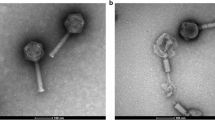Abstract
We report the expression of a cloned lysin gene of bacteriophase ØvML3 in dairy starter strains of the species Lactococcus lactis subsp. lactis and L. lactis subsp. cremoris. Lactococcal strains, which are sensitive to lysin, were unaffected by its expression during exponential growth but lysed after reaching stationary phase in GM17 broth at 30°C. Lysis could be prevented by osmotic buffering of the medium with sucrose. When grown in milk to mimic dairy fermentations, L.lactis subsp. cremoris strains which expressed the lysin gene lost viability earlier than control strains even when stored at low temperature. This autolytic phenotype has the potential to be exploited in flavor acceleration strategies during cheese manufacture.
This is a preview of subscription content, access via your institution
Access options
Subscribe to this journal
Receive 12 print issues and online access
$209.00 per year
only $17.42 per issue
Buy this article
- Purchase on Springer Link
- Instant access to full article PDF
Prices may be subject to local taxes which are calculated during checkout
Similar content being viewed by others
References
Davies, F.L., Underwood, H.M. and Gasson, M.J. 1981. The value of plasmid profiles for strain identification in lactic streptococci and the relationship between Streptococcus lactis 712, ML3 and C2. J. Appl. Bacteriol. 51: 327–337.
Shearman, C., Underwood, H., Jury, K. and Gasson, M. 1989. Cloning and DNA sequence analysis of a Lactococcus bacteriophage lysin gene. Mol. Gen. Genet. 218: 214–221.
Reiter, B. and Oram, J.D. 1963. Group N streptococcal phage lysin. J. Gen. Microbiol. 32: 29–32.
Oram, J.D. and Reiter, B. 1965. Phage-associated lysins affecting group N and group D streptococci. J. Gen. Microbiol. 40: 57–70.
van der Lelie, D., Chavarri, F., Venema, G. and Gasson, M.J. 1991. Identification of a new genetic determinant for cell aggregation associated with lactose plasmid transfer in Lactococcus lactis . Appl. Environ. Microbiol. 57: 201–206.
Gasson, M.J. 1980. Production, regeneration and fusion of protoplasts in lactic streptococci. FEMS Micro. Letts. 9: 99–102.
Lubitz, W., Harkness, R.E. and Ishiguro, E.E. 1984. Requirement for a functional host cell autolytic enzyme system for lysis of Escherichia coli by bacteriophage ØX174. J. Bacteriol. 159: 385–387.
Walderich, B., Ursinus-Wossner, A., van Duin, J. and Holtje, J.C. 1988. Induction of the autolytic system of Escherichia coli by specific insertion of bacteriophage MS2 lysis protein into the bacterial cell envelope. J. Bacteriol. 170: 5027–5033.
Holtje, J.V. and van Duin, J. 1984. MS2 phage induced lysis of E. coli depends upon the activity of the bacterial autolysins, 195–199. In: Microbial Cell Wall Synthesis and Autolysis. C. Nembela (Ed.). Elsevier Science Publishers, Amsterdam.
Ronda-Lain, C., Lopez, R., Tapia, A. and Tomasz, A. 1977. Role of the pneumonococcal autolysin (murein hydrolase) in the release of progeny bacteriophage and in the bacteriophage-induced lysis of the host cells. J. Virol. 21: 366–374.
Hill, J.E. and Wannamaker, L.W. 1981. Identification of a lysin associated with a bacteriophage (A25) virulent for Group A strepto cocci. J. Bacteriol. 145: 696–703.
Sonstein, S.A., Hammel, J.M. and Bondi, A. 1971. Staphylococcal bacteriophage-associated lysin: a lytic agent active against Staphylococcus aureus . J. Bacteriol. 107: 499–504.
Garcia, P., Garcia, E., Ronda, C., Tomasz, A. and Lopez, R. 1983. Inhibition of lysis by antibody against phage-associated lysin and requirement of choline residues in the cell wall for progeny phage release in Streptococcus pneumoniae . Current Microbiol. 8: 137–140.
Gasson, M.J. 1983. Plasmid complements of Streptococcus lactis NCDO 712 and other lactic streptococci after protoplast-induced curing. J. Bacteriol. 154: 1–9.
Terzaghi, B.E. and Sandine, W.E. 1975. Improved medium for lactic streptococci and their bacteriophages. Appl. Microbiol. 29: 807–813.
Anderson, D.G. and McKay, L.L. 1983. A simple and rapid method for isolating large plasmid DNA from lactic streptococci. Appl. Environ. Microbiol. 46: 549–552.
Powell, I.B., Achen, M.G., Hillier, A.J. and Davidson, B.E. 1988. A simple and rapid method for genetic transformation of lactic streptococci by electroporation. Appl. Environ. Microbiol. 54: 655–660.
Author information
Authors and Affiliations
Rights and permissions
About this article
Cite this article
Shearman, C., Jury, K. & Gasson, M. Autolytic Lactococcus Lactis Expressing a Lactococcal Bacteriophage Lysin Gene. Nat Biotechnol 10, 196–199 (1992). https://doi.org/10.1038/nbt0292-196
Received:
Accepted:
Issue Date:
DOI: https://doi.org/10.1038/nbt0292-196
This article is cited by
-
LysA2, the Lactobacillus casei bacteriophage A2 lysin is an endopeptidase active on a wide spectrum of lactic acid bacteria
Applied Microbiology and Biotechnology (2012)



